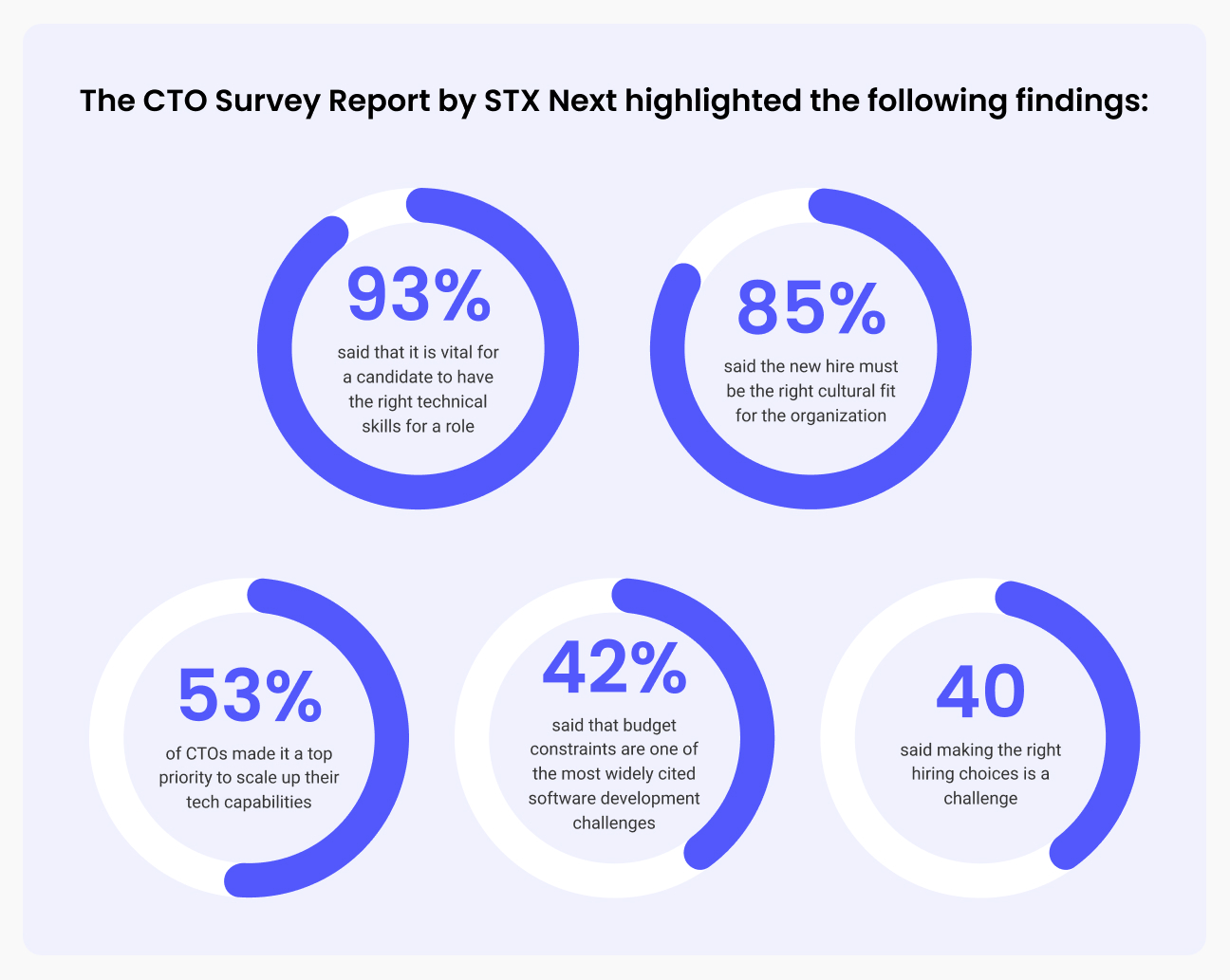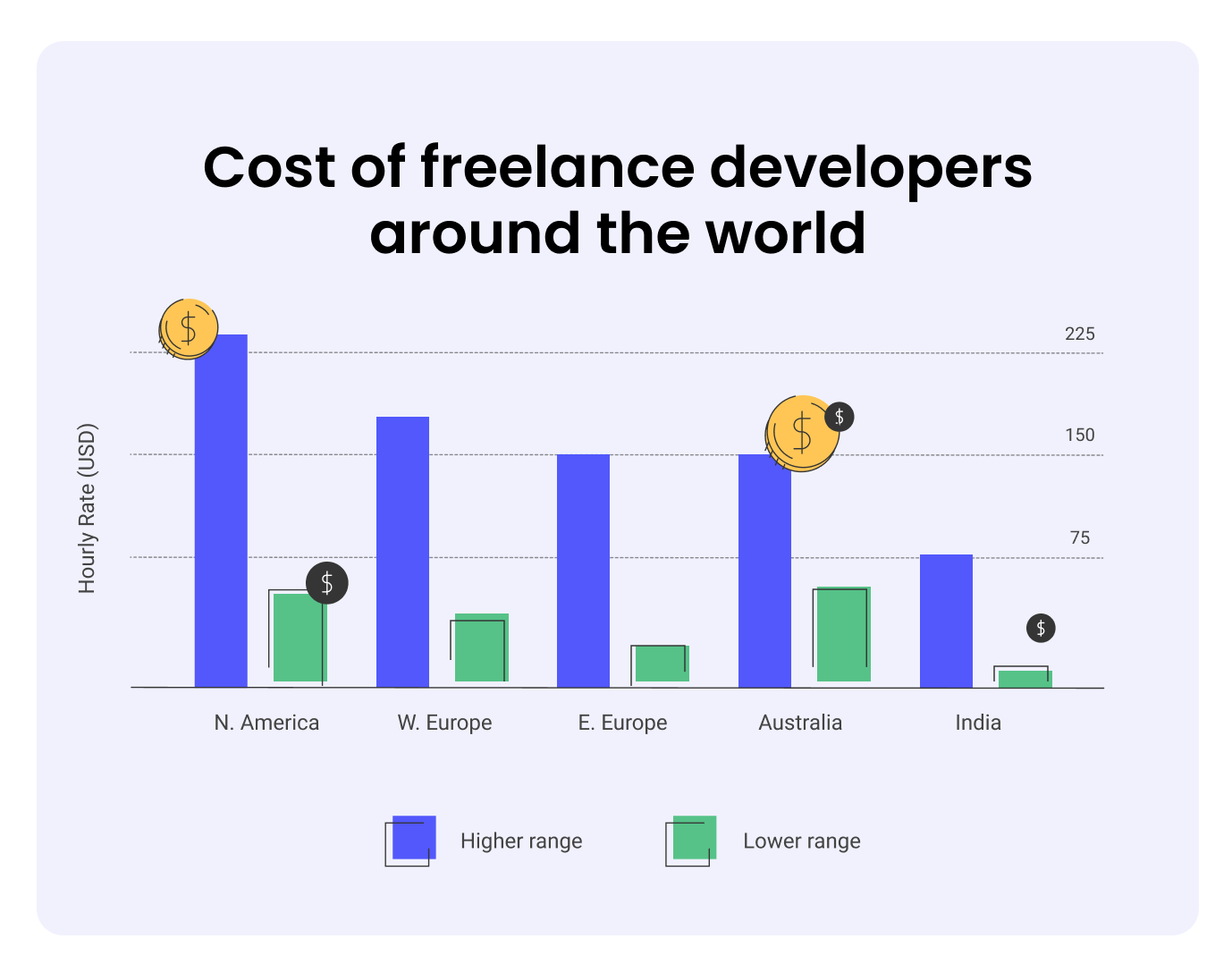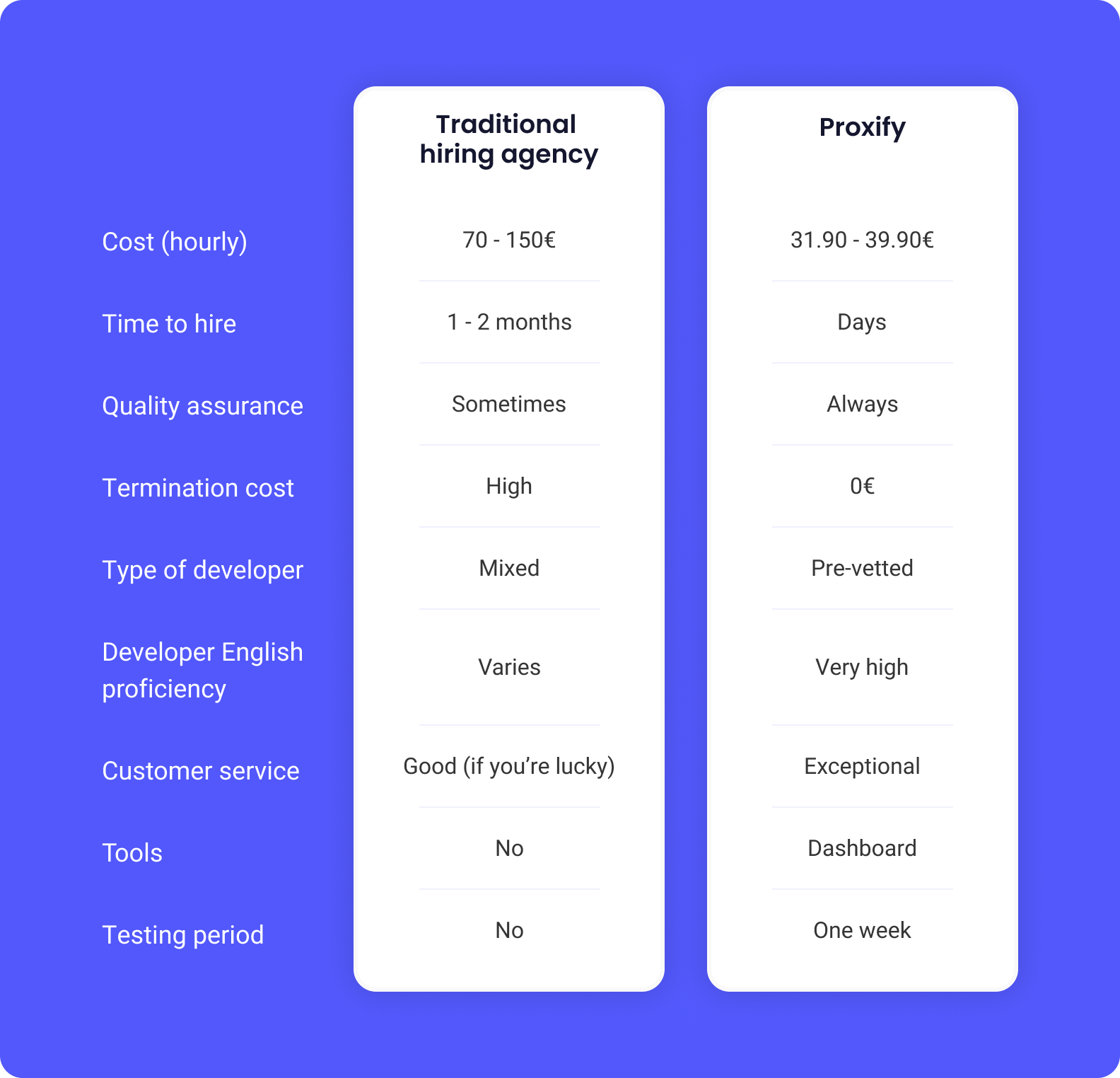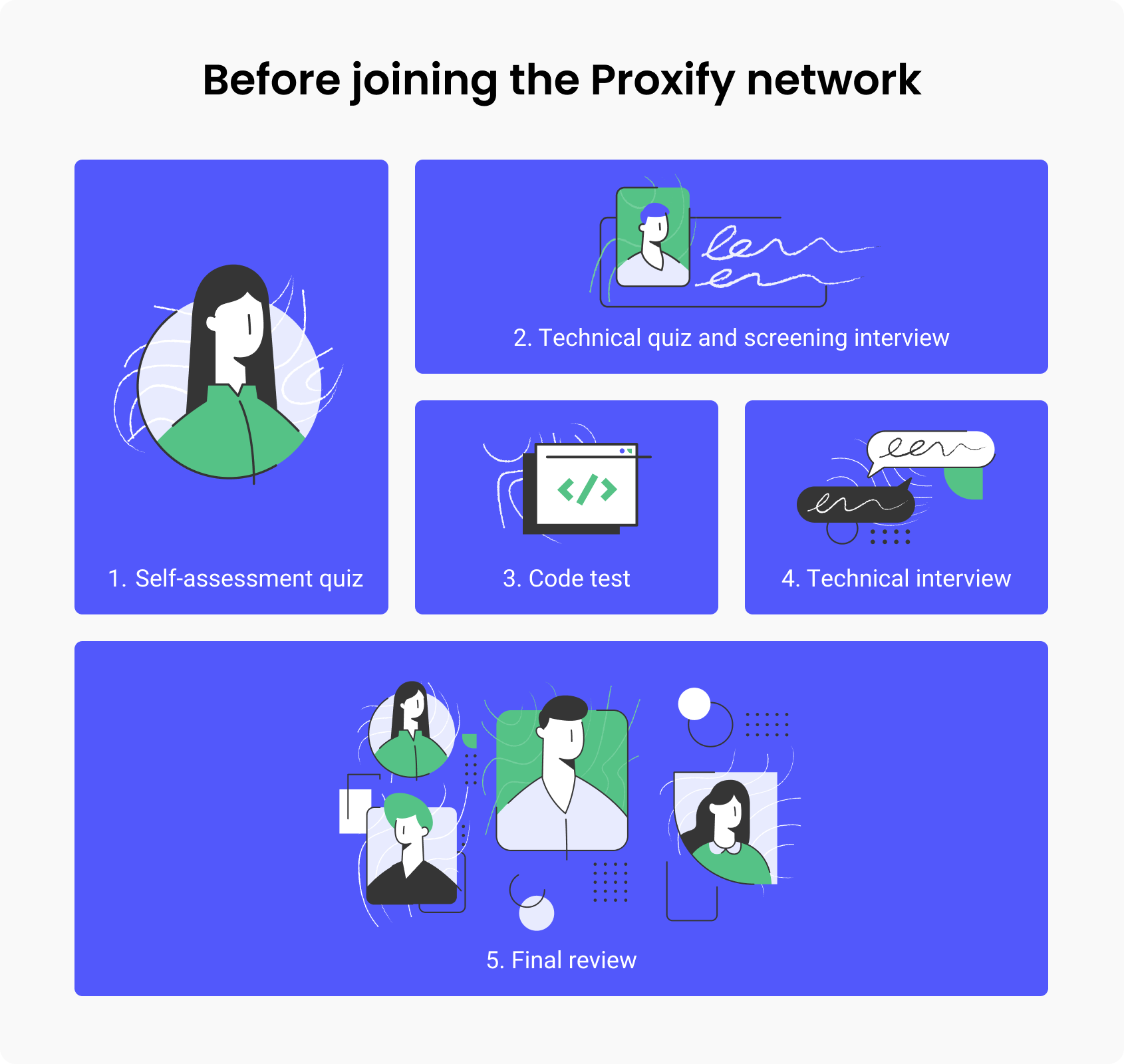As a decision-maker, you may feel trapped in analysis paralysis when planning your company’s growth strategy. CTOs are constantly looking for ways to reduce development costs while maintaining the speed of development necessary to meet business goals.
Many companies have been cutting costs to stay afloat during this economic uncertainty. This means they've been cutting back on spending on budget categories that CTOs' teams need, most notably staff, making it more difficult for you to do your job effectively and efficiently.
Some businesses have also had to let go of team members who were critical to their operations, impacting their ability to deliver on their ambitious roadmaps. This can be problematic for the companies trying to establish themselves as industry leaders – if you can't deliver on your ambitious roadmaps, you'll fall behind more nimble and resource-rich challengers.
As a CTO, you know that your company's future is dependent on the success of your products and services.
But what if your business is feeling the strain of an ever-increasing workload? What if your team has been stretched thin, and it seems like all their time is taken up with the day-to-day business operations? What if you're looking at an engagement that will take longer than expected?
If any of these sounds familiar, you're not alone. Many CTOs face challenges like these every day.
According to Bloomberg Businessweek’s survey of 3038 executives across industries, here’s what they had to say:
-
61% of respondents say they expect to increase their tech spending.
-
Of those, 72% will likely increase their budgets by 9% this year.

Because of these factors, you must be aware that you will be working with fewer resources than you’re used to having available – but don’t let this get you down! Instead, take this opportunity to rethink how to approach your job so that you can find new ways of achieving your results with fewer resources than before.
The recession
The current economic climate is harsh for many businesses. CTOs are not immune to the effects of the recession. You may face some unique challenges in ensuring that your company can stay afloat during this time of uncertainty.
While most companies are struggling to find ways to weather the storm, CTOs should be especially concerned about the recession on their resources and budget.
Layoffs happening in companies
Companies are downsizing, people are losing their jobs, and everyone's nervous about the future. In tech (and in many other industries), there's a lot of uncertainty and fear as investors, founders, and employees scramble to figure out how to save themselves and their businesses.
Many companies have been affected by this recession, and some of the biggest names in business news have fired several employees.
Meta
Recently, Meta announced that they would lay off more than 11,000 employees and have a hiring freeze in the next quarter. This has come as a surprise, granted the success of Facebook, its subsidiary, which, within eight years, was able to hit a peak market capitalization of over $104 billion. It begs the question, “how can a successful company like Meta fire so many employees at once?” Furthermore, “if it can happen to them, is my company going to experience the same as well?”
Twitter
Twitter reportedly laid off more than half of its employees to reduce operating costs and better position itself for future growth opportunities.
Twitter’s staff count was 7400 when Elon Musk bought the company. However, he downsized significantly to just over 2700 personnel. Twitter has more than 200 million daily active users and boasts the world's 15th most popular social media platform.
Klarna
Klarna, a Swedish fintech company that offers payment solutions for e-commerce platforms and online stores, also laid off part of its staff due to the current economic situation. They fired more than 700 employees, including those in the IT and recruitment sectors. The company has been struggling to find additional funding in recent months. Their CEO stated that the company is not planning on shutting down soon despite these layoffs.
HP
In addition to layoffs, some companies have to cut back on their spending on new software development and hardware. HP is one of them. They have reportedly promised to let go of up to 6000 employees over the next three years. HP's revenues declined 11 percent to $14.8 billion due to lower sales of PCs and laptops as consumer demand for this hardware decreased from a Covid-19 pandemic peak.
Stripe
Stripe, a financial services company, announced they will be laying off 14% of their company’s employees in November 2022. Patrick Collison, CEO of Stripe, said in a statement, this decision is mainly due to overhiring staff members.
“We were much too optimistic about the internet economy’s near-term growth in 2022 and 2023 and underestimated both the likelihood and impact of a broader slowdown.”
Collison added,
“We grew operating costs too quickly. Buoyed by the success we’re seeing in some of our new product areas, we allowed coordination costs to grow and operational inefficiencies to seep in.”
The layoffs are part of a larger trend in the tech industry as companies struggle with the downturn and look for ways to reduce costs without sacrificing their ability to innovate and compete effectively in new markets.
Common issues CTOs will face
In the past few years, CTOs have been forced to deliver more ambitious roadmaps with the same budget.
This is because of the changing market trends and new challenges that they face every day. Here are a few common issues that you may have to face:
Getting started can be hard
Many CTOs have a vague idea of what they need from their companies but need help figuring out where to start. The first step is asking for more information about what's already in place and what needs work.
A growing number of engagements
The number of engagements in an organization is generally increasing as technology evolves, which makes it harder for you to manage workloads.
The roadmap is too ambitious or vague
Too much can be lost in translation by not clearly defining your goals and objectives. If you don't clearly define what you want from your roadmap, you'll end up spending money on unnecessary features and features that aren't crucial for your business's success.
Not enough resources
One of the main issues you will have to face is decreased resources and budget at your disposal. This means that you will have fewer resources available to you than before, which could make it challenging to maintain the same level of productivity for your company or organization.
Too expensive
Hiring skilled independent developers is expensive. They often come with high salaries, benefits packages, and hefty recruiting fees. And if they're unhappy with their work environment, they're likely to leave after just a few weeks on the job, leaving you to pick up the pieces if they leave without completing tasks.
More competition
There may be increased competition from other companies or organizations looking for ways to stay afloat during this difficult time. This means that competition will be fierce among those trying to secure new clients or retain existing ones. It could lead many businesses into bankruptcy if they cannot find ways around these obstacles by making smart decisions on how best to spend money wisely while remaining competitively priced. Hence, as not lose out on any potential customers.
Less budget
IT budgets can often be one of the first areas businesses cut when financial troubles hit them. Companies must prepare for this possibility to retain key staff members and valuable infrastructure.
Not enough skilled workers
As a result of cutting costs, companies may reduce their workforces, so they don't have to pay as many salaries or benefits packages anymore. They may also increase their productivity by reducing their headcounts to save on overhead expenses such as office space rental fees or maintenance costs for computers/servers/etc.
This means that you may need more people trained in programming languages such as Python or Java, which require extensive training before someone can use them effectively. A lack of resources could lead to delayed engagements, hurting company revenues if it goes on too long.
A changing technology landscape
Cloud computing, big data, and artificial intelligence are some of the emerging technologies that are changing how we do business today. These changes require CTOs to make strategic decisions about incorporating these technologies into their products and services.
The roadmap
It’s no secret that the tech industry is changing rapidly. New tools and platforms are being created frequently, and many are free or low-cost. This can mean that it’s very easy to get distracted by all of the shiny objects out there and focus on things that aren’t important to your business.
To avoid this problem, you need to be clear about what you want from your roadmap and how it aligns with your overall vision for your company's future.
A roadmap is more than just a list of tasks and deadlines; it's a statement about how much your product will change and evolve and how you plan to achieve this. It's a comprehensive look at what your future holds.
As the Chief Technology Officer, you are the leader of your technology department. It's your job to set the direction for your business and ensure that you always work towards the right goals. But how do you do this without breaking the bank?
You can't do it alone. It's not just about having the right people in place — it's also about working with them effectively.
Step #1 Determine success for each project and task at the outset.
This will help everyone involved understand the goals of each engagement and task, which lets them know what success looks like – and where there may be room for improvement in the future. It also helps them prioritize tasks based on their individual value within the overall engagement or company goals as well as their values; if one job is deemed more important than another, they'll be able to prioritize accordingly without having any doubts about why they're doing so (because they'll understand what it means for both themselves and the company).
Step #2 Start with the end in mind: what are your goals? Why are you doing this? How will it benefit your team and organization?
Start by breaking down your goals into smaller pieces. If you're trying to decide how much money you should spend on your next campaign, ask yourself what's most important in scope, timing, or cost.
Then prioritize those pieces so you can know what's most important for the organization.
Ask yourself the following questions:
-
How can I make this better for my users?
-
If my users want a feature or functionality, how can I deliver that engagement or functionality within a given timeframe (or budget)?
-
How could this feature help them be more productive at work or home?
-
How does this fit into my company's vision for the next 12 months?
-
Does this engagement help us reach our goals as an organization?
-
Is it aligned with other initiatives we've been working on together recently?
-
Is it aligned with our customer's needs?
Step #3 Once you've got your vision, you can begin to plan how to achieve it.
Planning is crucial to any engagement and roadmap, especially if you're trying to build something new or change existing processes. This can be as simple as writing down a list of tasks needed to get from point A to point B. But it can also involve more sophisticated techniques like having visual aids such as diagrams or roll-out timelines that show how everything fits together.
If you're looking at something complex like an app release or website redesign, don't be afraid to take some time away from the actual work itself just so that you can think about how all the pieces fit together before diving in headfirst!
Step #4 Identify priorities – what's most important in priority, timing, or cost?
There are three main things to consider: priority, timing, and cost.
Priority – what's the most urgent and important task you can deliver?
Timing – how much time do you have?
Cost – how much can you spend?
Once you've identified these three areas, it's easier to ascertain how much can be accomplished with the resources at hand.
Step #5 Leverage your time wisely.
You don't need to write out a detailed plan for every engagement that comes down the pike – but you do need to ensure you're not wasting valuable time on engagements that won't lead to success.
Step #6 Decide whether any changes need to be made based on new information about costs or resources.
If there are only two people on your team, they will need more time to complete all of their tasks. You might want to consider hiring more people or outsourcing some work so that more people can focus on their tasks without having other things distracting them from their responsibilities at work.
The strategy
In 2024, it may seem impossible to accomplish ambitious goals within the budget available. But with careful planning, you can build a team with minimal resources and still make a huge impact this year.
So, how can you do this?
Prioritize your roadmap
Overly ambitious roadmaps are extremely common and can be incredibly stressful for the teams that have to deliver on them. The reason is relatively straightforward: if there are only so many hours in the day and only so many engineers, some goals will inevitably be sidelined while others come ahead of schedule. This makes it hard for teams to decide what's more important than something else – do you move forward with this feature now or hold off on it because you don't have time to finish it? Do you add more resources now or wait until your next release? Do you cut the scope now? There's no clear way to make these decisions.
The best way to avoid this problem is by prioritizing your roadmap before you commit to it.
How: Prioritize features by their business value – not by how much they cost or how long they take to build. When making these decisions, consider whether the engagement will significantly increase revenue, enable something that wasn't possible before, or increase customer satisfaction in a big way. This might seem obvious for some decisions, but when you're under pressure to deliver something quickly or when there are upfront costs involved in building out certain engagaments, it can be easy to push the non-urgent stuff down on your list of priorities.
Solving the developer shortage crisis
No CTO or CEO wants to risk their company stagnating due to a lack of expertise. But how can you find great talent when there is a lack of available developers?
First, list features and tasks you want to accomplish in a particular release cycle. You must have a clear line between what's on your roadmap and things that will be added later as an addendum. This way, if your team gets distracted or if something happens that prevents you from finishing everything in time for your deadline, not everything has been lost – you just have one feature less to offer for now.
Next, use these tasks as milestones for your team so they know what will happen in each iteration and when they can expect to reach specific results like an internal beta release. This ensures they stay aware of the weeds and plan enough to know what their schedule looks like and whether they'll be able to meet those deadlines.
Define tasks for each engagement
You can give your web developers a specific starting point by breaking out each engagement into sub-tasks and assigning them to individual team members in advance. If they're working remotely and are not going to be under your direct supervision every day, then having these tasks defined ahead of time is more critical than ever.
How: Create an agile process that includes regular check-ins (weekly standup meetings or monthly demos), milestones, and deadlines. This will help everyone stay on track and give them clear goals to work toward.
Consider outsourcing
An ambitious roadmap requires both a significant amount of work and a significant amount of investment. Balancing ambition and affordability can be difficult in an age where companies are trying to save money and cut costs.
To succeed at delivering an extensive and ambitious roadmap on time, the engagement must have a dedicated, focused team. Outsourcing allows you to access talent without going through the process of hiring new team members and training them internally. It also means you don't have to worry about managing the work by external teams since they're not part of your organization.
When building your team, you'll want to consider several factors, such as:
-
Skillset: What skills do they have? Are they experts in their field? Do they have experience working with users?
-
Experience: How much experience do they have with delivering large-scale projects?
-
Motivation: Are they excited about contributing to the overall success of your project?
-
Trust: Will they work together well and share information openly?
Hiring a distributed team means you don't have to commit to office space, making it easier and more to scale up and down as needed (and avoid paying for unused space).
How: You can deliver your product roadmap and growth by using alternative hiring options (like Proxify), so you save on salary costs. Proxify has a database of world-class independent developers highly skilled in top programming languages such as PHP, JavaScript, Python, HTML, CSS, SQL, and so much more. You get to hire an experienced developer within days, not months. So, if you have an engagement on your roadmap causing you extra grey hairs because of its urgency, we could get a skilled independent developer to join your team this week!
The cost of hiring across the globe
When hiring developers to build your product, one of the biggest challenges you face is finding the right person at the right price.
Finding top talent is a problematic, costly endeavor, but hiring remotely can save you time, money, and headaches.
Hiring remote developers can help you save money on hiring local talent, but it’s not always clear how much you can save.
To get a ballpark estimate of how much it costs per hour for a remote developer, you need to know exactly what kind of work they will be doing for your team. These are the estimated costs per hour and annual salary of full-time employees based on various sources. One must keep in mind that these costs are subject to change based on the developer’s skills and experience.
Frontend developer
Cost per hour – $61-80
Annual salary – $51,000 - $101,000
Backend Developer:
Cost per hour – $61-80
Annual salary – $81500 to $125000
Data Scientist
Cost per hour – $36.06 to $80.77
Annual salary – $97 546 to +$100 000
Fullstack developer
Cost per hour – $61-80
Annual salary – $80 674 to +$100 000
DevOps Engineer
Cost per hour – $56 to $66
Annual salary – $116,632 to $136,687
Here’s a further breakdown of the costs per hour for developers per continent.

The cost of hiring with Proxify
You might be surprised by the price if you're looking to hire web developers to build your app.
A quick search on other platforms will show that web developers are expensive; some charge market rates of $100+ per hour. That's not surprising – developers are in high demand and short supply, so they can make a lot of money by selling their time. The cost of hiring a developer in one country can be twice as much as hiring a developer in another country. This can make it difficult for companies to hire developers who are located where they need them most, as well as increase the chances that their business will fail if they have to pay such high costs for such limited resources.
Suppose you have a small engagement. Maybe you just need someone to make a simple change to your website or do some data entry. Or perhaps you want to hire a developer for just one week while they're between contracts at their current job – but still get them to work from home so that they don't take up any office space or other resources.
In either case, hiring a developer for just a few hours could cost thousands of dollars per month – and that's just for one person! If you want multiple developers working at once on different parts of your engagement, those costs quickly add up.
But what if there were another way? What if there was a way to get access to top-notch developers who would work for much less than what it would cost for a freelancer?
Proxify solves this problem by connecting businesses with independent developers worldwide, allowing you to pay less while still getting access to quality work. This means that if you're an employer looking for someone with a specific skill set, you can easily access them, no matter where they are located.
The best part? They can start in days.
With Proxify, you pay less for highly skilled independent developers. We love your ambition – as a CTO, you want flexible solutions to build a successful team that works on award-winning engagements while saving money. Sounds impossible, doesn’t it?
Not really. Here’s how we stand out from our competition.

Why are we so confident in the quality of our developers?
Because we select only 2% of candidates who apply for vacancies. They go through a thorough vetting process where we test their technical and soft skills, have several screening calls, and do a final review before we hire them.

You can always read through our step-by-step hiring process for more information.
Final thoughts
Don't let the future catch you off guard. Keep your budgets manageable. The more prepared you are, the better time you'll have to deliver a successful roadmap. It's all about planning and researching what works best for your organization.
You can effectively meet your KPIs, build a distributed team and complete your engagements within their respective deadlines and budgets when you plan accordingly.
Let Proxify handle the stresses of hiring and vetting skilled developers in top programming languages. All you need to do is get in touch with us and let us take care of the rest.

 English
English
 Norsk
Norsk








